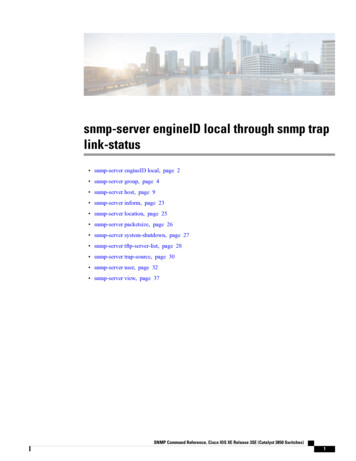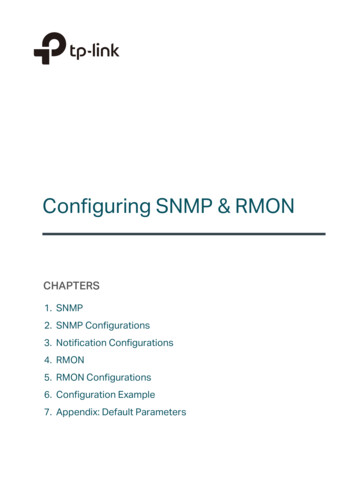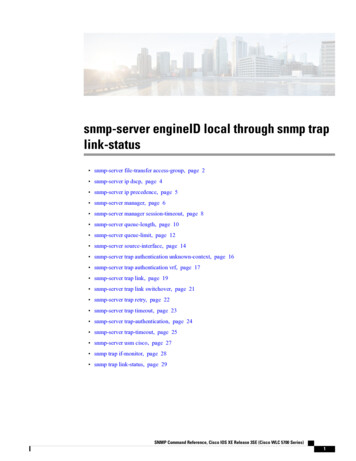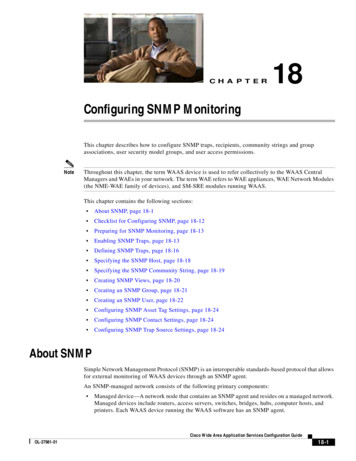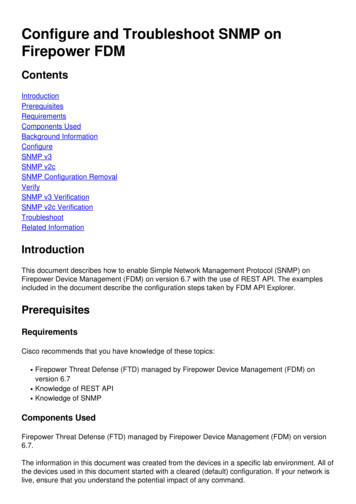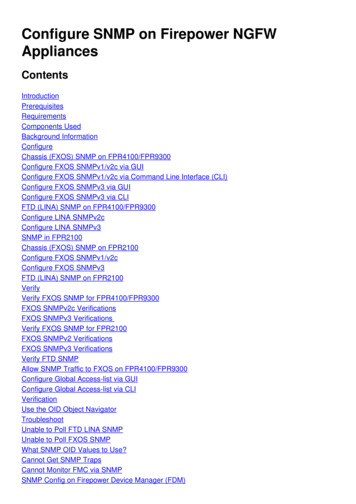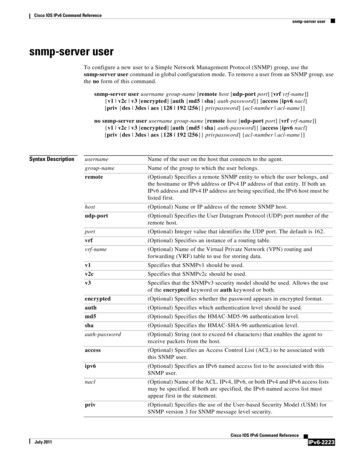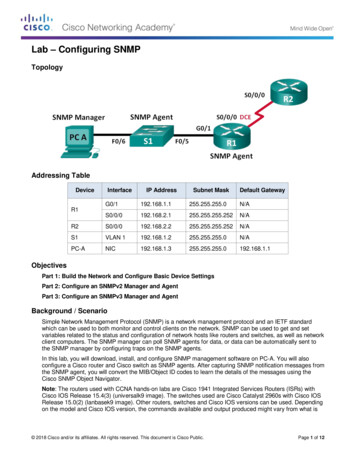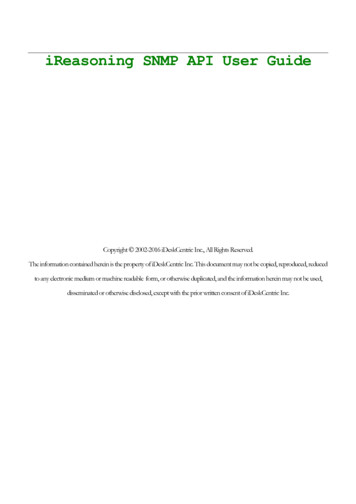
Transcription
I R E A S O N I N GS N M PL I B R A R YiReasoning SNMP API User GuideCopyright 2002-2016 iDeskCentric Inc., All Rights Reserved.The information contained herein is the property of iDeskCentric Inc. This document may not be copied, reproduced, reducedto any electronic medium or machine readable form, or otherwise duplicated, and the information herein may not be used,disseminated or otherwise disclosed, except with the prior written consent of iDeskCentric Inc.
I R E A S O N I N GS N M PL I B R A R YTable of ContentsINTRODUCTION . 1About this document . 1Target Audience . 1INSTALLATION . 2Requirements . 2Installation Procedures . 2USING iREASONING SNMP LIBRARY . 4Overview and Architecture . 4UML diagram . 7Configuration . 8Logger configuration . 8Usage examples . 8SnmpSession class . 8Synchronous SNMP Operations . 9Asynchronous SNMP Operations . 10SNMP Table Retrieval . 11SnmpTrapdSession class . 12SnmpTrapSender class . 13SnmpPoller class . 13Java Applet Example . 14FAQ . 15RESOURCES AND REFERENCE . 19GLOSSARY OF TERMS . 20
I R E A S O N I N GS N M PL I B R A R YINTRODUCTIONAbout this documentThe purpose of this document is to provide the reader with enough knowledge tostart developing software using the iReasoning's SNMP toolkit. Some examples areprovided to better illustrate the usage of APIs. This document is not intended toprovide detailed information about the SNMP APIs. To effectively use the APIs,readers need to refer to javadoc help that has detailed instructions and examples.The iReasoning SNMP API is a Java toolset that greatly simplifies the development of applications formanaging SNMP agents. It provides full support for SNMPv1, SNMPv2c and SNMPv3. The design andimplementation of this library were based on object-oriented methodology and followed recognizeddesign patterns. These advantages, combined with a highly optimized code base, make iReasoningSNMP library stand out from the competition.Target AudienceThis document is intended for users and engineers who are responsible for developing SNMP basedmanagement applications. A user of this software does not have to be an expert in network managementfield. He or she should, however, be familiar with basic SNMP concepts, such as SNMP GET andGET NEXT operations. Some basic knowledge about Java language is required to understandexamples. This software is designed to minimize the learning curve for users and achieve a givenprogramming job with less code. A new user should therefore find it quite easy to learn and master thisproduct.
I R E A S O N I N GS N M PL I B R A R YChapter2INSTALLATIONRequirementsØ JDK1.2 or a later version must be installed. You can download JDK fromthe Oracle’s web site (http://java.com )Ø At least 32MB memory is requiredInstallation ProceduresØ Download and unzipDownload iReasoning SNMP library and unzip it to the desired directory,for example, C:\lib\iReasoning\snmpThe directory structure will look like this:Directory NameDescriptionlibcontains binary jar filesjavadoccontains javadoc HTML filesexamplescontains examples source codeconfigconfiguration files
I R E A S O N I N GS N M PL I B R A R YØ Set up CLASSPATHireasoningsnmp.jar needs to be added to CLASSPATH environmentvariable. On Windows:If the iReasoning SNMP library is installed at C:\lib\iReasoning\snmp,use the commandset CLASSPATH SSPATH%On Unix/Linux:If iReasoning SNMP is installed at /usr/local/ireasoning/snmp, use thecommandCLASSPATH /usr/local/ireasoning/snmp/lib/ireasoningsnmp.jar ; export CLASSPATHØ Run example program (Optional)Example code is located at examples/snmp directory. They were precompiled and jarred into lib/examples.jar. To verify that everything isworking, you can follow the following steps to run the example programs.1) Add examples.jar to CLASSPATH. Take similar step, for instance,On Windows:set CLASSPATH %(assuming examples.jar is located at C:\lib\iReasoning\snmp\lib\)On Unix/LinuxCLASSPATH /usr/local/ireasoning/snmp/lib/examples.jar ; export CLASSPATH(assuming examples.jar is located at /usr/local/ireasoning/snmp/lib/ )2) Runjava snmpgetnext hostname .1.3(Retrieve the first SNMP variable)where hostname is the host name or IP address of an snmp agent.If you do not have an snmp agent, you can run snmpd.exe (onWindows) to start an agent listening on port 161.Or you can use runexample.bat script to run examples on Windows.
I R E A S O N I N GS N M PL I B R A R YChapter3USING iREASONINGSNMP LIBRARYOverview and ArchitectureThe iReasoning SNMP library is designed and implemented using object orientedmethodology and recognized design patterns. One of its design goals was tominimize the learning curve of SNMP library for developers. Users only need toknow a few classes, most of complex works are hidden from them.All versions of SNMP (SNMPv1, SNMPv2c and SNMPv3) are supported in onelibrary, and users do not have to learn the detailed underlying differences betweenthree SNMP versions. Users can always use a unified interface to access SNMPagents speaking different SNMP protocols. The example code shipped with thisproduct clearly demonstrates the simplicity of this library. In those code, at firstglance, users will realize how simple it is to write code to communicate with SNMPagents.The central class is the SnmpSession. It provides all the necessary mechanism touse SNMP operations. A session represents a communication channel between anSNMP manager and an agent. To communicate with multiple agents, multiplesessions have to be created. Each session is corresponding to each communicationchannel. A session needs to be created and then a connection needs to beestablished with the agent. After session is initialized, you are ready to issue SNMPcommands against the agent. There are four basic SNMP operations: GET,GET NEXT, SET, GET BULK (SNMPv2c and SNMPv3). They arerepresented in SnmpSession class as snmpGetRequest, snmpGetNextRequest,snmpSetRequest, snmpGetBulkRequest methods. High-level SNMP operations,such as GET TABLE and WALK, are represented as snmpGetTable andsnmpWalk methods. When a session is no longer needed, it needs to be closed toavoid resource leak.SnmpTrapdSession class is provided for creating trap receiver programs. A trapdsession can be created and then waits for traps sent by agents. This session is ableto understand all the SNMPv1, SNMPv2c and SNMPv3 traps.
I R E A S O N I N GS N M PL I B R A R YBoth synchronous and asynchronous requests are supported in SnmpSession.When sending synchronous requests, the session can only send one request at atime. It must block and wait for the reply to the request before issuing next one.This mode is easier to understand and implement. When using asynchronousrequests, the session does not need to wait for each reply. In this case, a session hasa thread handling the replies and notifying callers when replies arrive.SNMP data types are represented as child classes of SnmpDataType class. Theremote agent is represented as the SnmpTarget class. Each agent is represented bya single SnmpTarget object. An SnmpTarget can be instantiated with the IPaddress (or host name) and port number of the remote agent. Other propertiesof agent, such as community name, can also be specified. The class diagram isshown in figure 1. For detailed information about classes, you can refer to thejavadoc files shipped with this library.The SNMP protocol uses UDP as the default transport layer protocol. UDP isconnectionless and the delivery of packets is not guaranteed, but it is an efficientway to transport small amount of data. The iReasoning SNMP API architecturealso supports TCP besides UDP. SNMP over TCP is a good fit for transferringlarge amount of data. The built-in features of TCP, such as flow control andefficient segmentation, make TCP perform better than UDP in this case. The agenthas to be able to support SNMP over TCP so that the SNMP manager can chooseTCP as an underlying transport layer protocol.
I R E A S O N I N GS N M PL I B R A R YA MIB parser utility is also included in the library. MibUtil class can be used toparse MIBs and resolve OID and variable binding’s value. It can look up MIBnode name from OID value as well. MibUtil’s parseMib method can parse MIBand return a tree data structure. Here is an output from mibparser.java samplecode, which illustrates how to use MIB parser.
I R E A S O N I N GS N M PL I B R A R YUML diagramSessionTrarget-target : Trarget getState() : int#open(in target : Trarget) close()11SnmpSessionSnmpTrapdSession send(in pdu : SnmpPdu) : SnmpPdu snmpGet(in oid : SnmpOID) : SnmpPdu snmpGetNext(in oid : SnmpOID) : SnmpPdu snmpGetBulk(in pdus : SnmpOID[], in nonRepeaters : int, in maxRepetitions : int) : SnmpPdu snmpSet() waitForTrap() : SnmpDataType-host : String-port : int-snmpTarget : SnmpTarget*SnmpTarget-community : String11*SnmpPdu11* interface SnmpDataType getType() : int getTypeString() : String copy() : SnmpNull11SnmpGauge32SnmpIpAddressSnmpOpaqueFigure 1. iReasoning SNMP library class diagram
I R E A S O N I N GS N M PL I B R A R YConfigurationConfig files are located at ./config directory by default. You can add a javaenvironment variable to set a new config directory. For example:java -Dcom.ireasoning.configDir d:\config In this example “d:\config” is the new config directory.Logger configurationThe iReasoning SNMP library has a built-in logger. The logger is configurablethrough the Logger.prop file located at ./config directory. You can change thelogging level or just disable the logger. The output of logging message is alsoconfigurable. It can be system’s standard out or file. Check out Logger.propfor detailed information.The popular open source log4j package is also supported. To switch to log4jlogger, you just need to add one line of code in the beginning of (true);If using log4j, the Logger.prop will no longer be used. You need to configurethe log4j logger or provide a config file for it. You can still use the logmethods in the Logger class to log messages, then they will be delegated tocorresponding methods in log4j logger.Usage examplesIn your source file, you need to import the following iReasoning SNMPpackages:import com.ireasoning.protocol.*;import com.ireasoning.protocol.snmp.*;SnmpSession classThe core class of iReasoning SNMP library is SnmpSession class. It representsa communication channel between an SNMP manager and an agent. Similar toother communication classes, it needs remote host name and port number so itcan connect to the remote agent, and the channel needs to be closed after it isfinished. This class provides necessary methods to do SNMP queries, such asSNMP GetRequest, GetNextRequest, SetRequest, InformRequest, GetTable,and Walk. The lowest level method is "public SnmpPdu send(SnmpPdu pdu)",which encodes and sends out SnmpPdu object to the agent. The request
I R E A S O N I N GS N M PL I B R A R Ymethods, such as snmpGetRequest, snmpGetNextRequest etc., use“send(SnmpPdu pdu)” method internally to do the job. So if in some cases youfind the higher-level methods cannot meet your needs, you can use sendmethod directly. The snmpget.java and snmpgetnext.java demonstrate how touse that method. But in most cases, it is recommended to use higher-levelmethods to reduce the chance of programming mistakes.Synchronous SNMP OperationsSNMP manager application sends out a synchronous SNMP request to anagent and blocks until response comes back. Usually, synchronous operationsare easier to program than asynchronous operations.Synchronous operations in SnmpSession class include snmpGetRequest,snmpGetNextRequest, snmpGetBulkRequest, and snmpGetTable, etc.The following is a simple example on how to use SnmpSession class to dosynchronous SNMP GetRequest.1.SnmpTarget target new SnmpTarget(host, port,readCommunity,2.writeCommunity, version);3.SnmpSession session new V3Params(user, authProtocol,7.authPassword, privPassword);8.}9.10.SnmpPdu retPdu session.snmpGetRequest(oids); //send out get .close();In this example, it creates an SnmpTarget object that represents a remoteagent. An SnmpSession object is created next with the SnmpTarget object. Ifremote agent only supports SNMPv3, additional information has to beprovided. Then we call snmpGetRequest method of SnmpSession class to sendout the request to the agent. Check out snmpget.java, snmpgetnext.java,snmpgetbulk.java, snmpwalk.java, and snmpgettable.java (in./examples/snmp/) for complete implementation examples.SnmpSession.snmpGetRequest and other methods also take MIB node namebesides numerical OID. However you need to call loadMib methodbeforehand to load corresponding MIB files first, then SnmpSession cantranslate name into numerical OID.
I R E A S O N I N GS N M PL I B R A R YAsynchronous SNMP OperationsSnmpSession class provides several asynchronous SNMP operation methods,such as asyncSnmpGetRequest, and asyncSnmpGetNextRequest, etc. Compared withsynchronous SNMP operations, asynchronous SNMP operations can send outmore SNMP requests in the same amount of time because SnmpSession is notblocked waiting for responses. To receive responses, we need a classimplementing Listener interface, therefore “handleMsg(Object session, Msg msg)”method will be called when a response is received.The following is a simple example on how to use SnmpSession class to doasynchronous SNMP GetRequest.1.SnmpTarget target new SnmpTarget(host, port,readCommunity,2.writeCommunity, version);3.SnmpSession session new V3Params(user, authProtocol,7.authPassword, ssion.asyncSnmpGetRequest(oids);11. .12.//In a class implementing Listener interface13.public void handleMsg(Object session, Msg msg)14.{ // received a pdu15.SnmpPdu pdu (SnmpPdu) msg;16.print(pdu);17.}In this example, it creates an SnmpTarget object that represents a remoteagent. An SnmpSession object is created next with the SnmpTarget object. Ifremote agent only supports SNMPv3, additional information has to beprovided. A listener needs to be registered with this session, so when thissession receives a response, listener’s handleMsg method will be invoked. Thenwe call asyncSnmpGetRequest method of SnmpSession class to send out therequest to the agent. It returns immediately after PDU is sent, unlikesynchronous methods that block until response comes back. Check outsnmpasyncget.java (in ./examples/snmp/) for complete implementationexamples.
I R E A S O N I N GS N M PL I B R A R YSNMP Table RetrievalSnmpSession class provides a useful method to retrieve a whole MIB table.1.2.3.4.5.6.7.8.9.10.11.12.13.SnmpSession session new SnmpSession(host, port, community,community, version);if(isSnmpV3){session.setV3Params(user, authProtocol, ;//load MIB-IISnmpTableModel table session.snmpGetTable(“ifTable”);for (int i 0; i table.getRowCount() ; i ){print(table.getRow(i));}In this example, MIB-II is loaded by calling loadMib2 method. Then we can usesnmpGetTable method with MIB node name “ifTable” to retrieve whole table.Table information is stored in SnmpTableModel object. SnmpTableModelimplements Swing’s TreeModel interface, so it can be easily used to create aJTable component. The following is a screenshot of tcpConnTable retrieval(result of running snmpgettable.java example that is bundled with this product).SnmpSession also provides snmpGetTableColumn method to retrieve a specificcolumn of a table.
I R E A S O N I N GS N M PL I B R A R YSnmpTrapdSession classSNMP traps are initiated by agent or manager signaling changes or alarmsoccurred. This class is a daemon session that can be easily used to create SNMPtrap receiver. Trap version contained in the UDP packet can be automaticallyfigured out, so it can understand all types of trap.The following is a simple example on how to use SnmpTrapdSession class tocreate a trap receiver.1.SnmpTrapdSession session new addV3Params(user, authProtocol, authPassword,5.privPassword, trapSenderEngineID);6.7.}8.//register with session, so handleMsg will be called when trap comes9.session.addListener(this);10. //blocks and wait for trap11. session.waitForTrap();12. .13. public void handleMsg(Object msgSender, Msg msg)14. {15.System.out.println((SnmpDataType)msg);16. }The first line of code creates an SnmpTrapdSession listening on a certain portnumber. Additional information is needed if it expects SNMPv3 traps. Line 9registers for trap event, so handleMsg will be called when a trap arrives. Line 11blocks and waits for traps. Line 13-16 is a callback method that prints outreceived traps. Check out snmptrapd.java for a complete implementation.
I R E A S O N I N GS N M PL I B R A R YSnmpTrapSender classThis class can be used to send out all three versions of SNMP traps. AlthoughSnmpSession class also can be used to send out trap if properly configured, it ismuch easier to do it using this class instead.Here is a simple example demonstrating sending out SNMPv1 traps.1.2.3.4.5.SnmpTrapSender trapSender new SnmpTrapSender();SnmpV1Trap trap new );trap.setGeneric(code);trapSender.sendTrap(host, port, trap, community);Line 1 creates an SnmpTrapSender class. Line 2 to 4 form an SnmpTrapobject. Line 5 sends out the trap to the destination. Check out snmptrap.javafor a complete implementation.SnmpPoller classThis class can send out SNMP GetRequest and GetNextRequest to agentsperiodically. The interval is configurable.Here is a simple example demonstrating using SnmpPoller class.1.2.3.4.5.6.7.8.9.10.11.SnmpTarget target new SnmpTarget(host, port, community,community, version);SnmpSession session new ms(user, authProtocol,authPassword, privPassword);}SnmpPoller poller new r.snmpGetNextPoll(oids, interval);.12. public void handleMsg(Object sender, Msg msg)13. {14.SnmpPdu pdu (SnmpPdu) msg;15.print(pdu);16. }
I R E A S O N I N GS N M PL I B R A R YLine 1 to 8 create an SnmpSession and open a connection to the remoteagent. Line 9 creates an SnmpPoller class using the just created SnmpSessionobject. Line 10 registers itself with the SnmpPoller object, so its handleMsgmethod will get called if SnmpPoller finishes a request. Line 11 starts the pollerand tells poller to send GetNextRequest to the agent at specified intervals.Check out snmppoll.java example for a complete implementation.Java Applet ExampleJava code and HTML files are located at examples/snmp/applet. This exampleshows how to retrieve agent information within a java applet. Because ofsecurity restrictions of Java applet, the snmp agent and the web server have tobe running on the same machine.
I R E A S O N I N GS N M PL I B R A R YFAQQ. What is iReasoning SNMP API?A. iReasoning SNMP API is the industry leading SNMP library, which provides ahigh performance, cross platform Java API for building network managementapplications. All SNMP versions (SNMPv1, SNMPv2c and SNMPv3) are fullysupported. It is written in Java, and designed from the ground up to support allSNMP versions. There is no legacy code which only for a certain version of SNMPprotocol. All code base are highly optimized to maximize performance andminimize overhead.Q. What're the advantages of iReasoning SNMP API over its competitors?A. Here are just some of the advantages over our competitors. Ease of use. You can take a look at the example code, such assnmpgetnext.java or snmpwalk.java , to see how easy to implementSNMPv1/v2c/v3 operationsHigh performance. All code bases are highly optimized to maximizeperformance and minimize overheadThe first Java SNMP product to support both DES and strong 128-bitAES encryption algorithmsSupport all SNMP versions (SNMPv1, SNMPv2c, SNMPv3)Conform to the EJB specificationRobust and powerful SMIv1/SMIv2 MIB parserSupport both UDP and TCP transport layersQ. Do SNMP security vulnerabilities reported by CERT affect iReasoningSNMP API?A. The Finland Oulu University Secure Programming Group ( OUSPG)discovered numerous vulnerabilities in SNMP implementation from manydifferent vendors. Vulnerabilities in the decoding and subsequent processing ofSNMP messages by both managers and agents may result in unauthorizedprivileged access, denial-of-service attacks, or cause unstable behavior.iReasoning has investigated how these vulnerabilities may impact our SNMPlibrary and has found the following results: VU#107186 - Multiple vulnerabilities in SNMPv1 trap handlingSNMP trap messages are sent from agents to managers. A trap messagemay indicate a warning or error condition or otherwise notify the managerabout the agent's state. SNMP managers must properly decode trapmessages and process the resulting data. In testing, OUSPG found multiplevulnerabilities in the way many SNMP managers decode and processSNMP trap messages.iReasoning SNMP library successfully passed all the 24100 tests in OUSPGtest suite! We conclude this advisory does not affect iReasoning SNMPlibrary.VU#854306 - Multiple vulnerabilities in SNMPv1 request handlingSNMP request messages are sent from managers to agents. Requestmessages might be issued to obtain information from an agent or toinstruct the agent to configure the host device. SNMP agents must
I R E A S O N I N GS N M PL I B R A R Yproperly decode request messages and process the resulting data. In testing,OUSPG found multiple vulnerabilities in the way many SNMP agentsdecode and process SNMP request messages.This advisory is not applicable to iReasoning SNMP library because it doesnot have SNMP agent functionality and does not accept SNMP requestmessages.Q. Does iReasoning SNMP API conform to the EJB specification?A. If asynchronous mode is not used, no thread is created. And EJB specificationallows client side socket. So SNMP library conform to the EJB specification.However, if asyncSend method in SnmpSession is used, it creates a new thread andviolates EJB specification. Asynchronous mode is not recommended to be used inenterprise java beans. SNMP libraries from other vendors create thread no matterwhich mode to use, they generally do not conform to EJB specification.Q. How do I get started with this library?A. First of all, a basic understanding of SNMP and Java is required. This user guideprovides nice introduction and usage examples about this library. Then you canstart with example code shipped with this product. Those example code clearlyillustrates how to write simple programs to do SNMP GetRequest,GetNextRequest, Walk, etc. Example code is also integrated into javadoc help. Soyou can read them from browsers. You also need an SNMP agent to test withmost of example code. If you do not have a agent for testing purpose, you can runthe snmpd.exe on windows to start an SNMP agent listening on port 161.Q. Can I build an SNMP agent with iReasoning SNMP API?A. No. You can use iReasoning Agent Builder to build SNMP agent. iReasoningAgent Builder is a superset of SNMP API, it also provides tools for building agent.Q. Which versions of SNMP are supported by iReasoning SNMP library?A. iReasoning SNMP library support SNMPv1, SNMPv2c and SNMPv3.However if you only purchase license for iReasoning SNMPv2 library, SNMPv3support is not included.Q. How's the SNMPv3 support?A. iReasoning SNMP library fully supports SNMPv3, including the completeVACM and USM security model (HMAC-MD5, HMAC-SHA1, HMAC-SHA2,CBC-DES, CFB128-AES-128, CFB128-AES-192, CFB128-AES-256). It hassuccessfully passed a number of interoperability tests with other SNMPv3 vendorsand their SNMPv3 implementations. Now it is used as a de-facto referenceSNMPv3 implementation for other implementers.Q. What is AES standard? And how does 128-bit AES encryption compareto DES?A. Excerpt from NIST (National Institute of Standards and Technology) website:"The Advanced Encryption Standard (AES) is a new Federal Information Processing Standard(FIPS) Publication that will specify a cryptographic algorithm for use by U.S. Governmentorganizations to protect sensitive (unclassified) information. NIST also anticipates that the AES
I R E A S O N I N GS N M PL I B R A R Ywill be widely used on a voluntary basis by organizations, institutions, and individuals outside ofthe U.S. Government - and outside of the United States - in some cases.The AES is being developed to replace DES, but NIST anticipates that Triple DES willremain an approved algorithm (for U.S. Government use) for the foreseeable future. SingleDES is being phased out of use, and is currently permitted in legacy systems,only.Assuming that one could build a machine that could recover a DES key in a second (i.e., try 255keys per second), then it would take tha
environment variable to set a new config directory. For example: java -Dcom.ireasoning.configDir d:\config In this example "d:\config" is the new config directory. Logger configuration The iReasoning SNMP library has a built-in logger. The logger is configurable through the Logger.prop file located at ./config directory. You can change the
